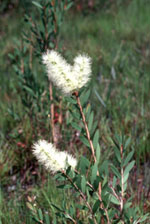Threats to Birds - Melaleuca (Melaleuca quinquenervia)
Overview Melaleuca was imported from Australia in 1906 to dry out marshes in Florida. Melaleuca had infested approximately 500,000 acres of natural and disturbed lands in south FL. It is highly flammable, and following fires, melaleuca spreads vigorously. The Office of Technology Assessment has called it, “the most serious threat to the integrity of all south Florida’s natural systems.” Melaleuca reduces species diversity in marshlands by 60% - 80%. The Loxahatchee NWR, with 257 species of birds, is losing 10 acres/day to Malaleuca. Greater than 80% of the habitat area in Loxahatchee is affected. Melaleuca destroys nesting habitat and reduces forage for prey species.
Description
This tree grows 20-25 meters tall; bark is whitish or pale brown, spongy and exfoliating. Leaves are alternate, lance-shaped; flowers in cylindrical spikes with cream petals; fruit is woody, short and cylindrical. Large numbers of seeds are stored on the tree in the fruiting capsules which are released when fire or other disturbance occurs.
Birds Affected
Wading birds, Wood Stork; Snail Kite.
Control
Releases millions of seeds when it is stressed by fire or herbicides, so this treatment is not practical. Small seedlings can be hand-pulled. After cutting, larger trees can then be applied with herbicide to prevent re-sprouting. Bio-control using the melaleuca snout weevil and the melaleuca psyllid can augment chemical and mechanical efforts. An area-wide demonstration project, “TAME Melaleuca” is underway to educate the public. |
